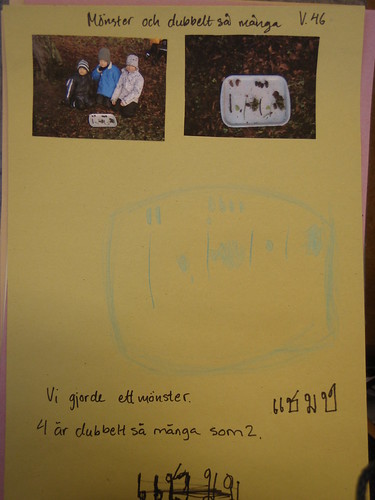The morning began in a preschool class (children aged 6-7; compulsory schooling does not begin until age 7 in grade 1). The pupils were giving each other massages as part of their 'Social & Emotional Training', a scheme that this particular school follow that focuses on children's interpersonal skills.

Following this session whilst the children went to play the teacher introduced us to how she teaches mathematics. This is mainly done in a kinesthetic way, for example with their weekly visits for 'Forest Maths' where they children will be set tasks such as collecting a particular number of items, then twice as many, three times as many etc., or items twice as long, half as long and so on. This work is recorded with a digital camera and then at a later time in class drawn about by the children who also comment about it for the teacher to scribe on their work. There is a simple opportunity here for effective additional use of ICT which I think they are missing - having the children adding voice recordings about the digital pictures of the work they did for instance.

In the grade 1/2 class (7-9 year olds) we witnessed the school's rather revolutionary scheme of 'writing to reading'. This involves the children working entirely on the computer for their early writing and not using a pen for this until they have become confident at reading and writing electronically. They use a piece of software that sounds out each letter as it is typed on the keyboard, and then each word as it is completed. It was evident that the children were making the letter sounds to themselves when searching for the keys on the keyboard, and also self-correcting their work if the voice-read word did not sound like they expected. The children were left to write relatively independently; the brief in this case was to include 2 teacher-selected words in their particular piece of writing. We were told that after the children had used this system for a year or so they were then introduced to writing with a pen, and were already able to form letters correctly without having had specific handwriting lessons. I suppose this is due to the fact that they are able to visualise the correct letter shapes that they are so used to seeing on the screen (a comic-sans type font is used). Additionally were told that when this was trialled over a year - one class using this method and the other a traditional method, at the end of that time the 'writing to reading' group had a higher level of reading and writing as well as neater handwriting. This was certainly an interesting thing to see and I hope to get a copy of the project research to look at in more detail and report back on.






2 comments:
Thanks for these entries about your Swedish trip. The 'writing to reading ' software sounds like Clicker 5 ( it can be configured to do that) did it seem so to you?
Hi Tricia thanks for reading.
No, the writing to reading software is not clicker. It's a plugin that sits alongside MS word. Unlike Clicker5 which will speak the letter names as you type, this software was speaking the letter sounds phonetically. The children were obviously sounding out the letters to themselves whilst searching for keys on the keyboard.
Post a Comment